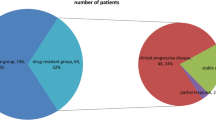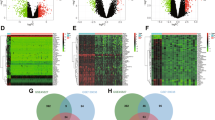Abstract
Esophageal squamous cell carcinoma (ESCC) is one of the most aggressive cancers and the primary cause of cancer-related mortality in China. micoRNA plays a vital role during tumor initiation and malignant progression. miR-4306 has been reported to negatively regulate aggressive cell phenotypes in triple-negative breast cancer (TNBC). Nevertheless, the function of miR-4306 in ESCC was still not clear. In this study, we detected miR-4306 expression by quantitative real-time reverse transcription-PCR (qRT-PCR) and found that miR-4306 expression was downregulated in human ESCC tissue samples and cell lines. Moreover, miR-4306 overexpression could restrain ESCC cell proliferation, migratory and invasive ability and epithelial-mesenchymal transition (EMT), promote cell apoptosis after treatment with or without cisplatin. In contrast, inhibiting the expression of miR-4306 showed the opposing results. Furthermore, we explored the molecular mechanism of effects of miR-4306 and found that miR-4306 inhibited the expression of SIX3 by interaction with SIX3 3′UTR in ESCC cells, and SIX3 overexpression significantly reversed the effect of miR-4306-mediated ESCC cells proliferation. The current study provided evidence of miR-4306 as a tumor suppression gene in ESCC.






Similar content being viewed by others
Data availability
The datasets used and/or analyzed during the current study are available from the corresponding author on reasonable request.
References
Bray, F., Ferlay, J., Soerjomataram, I., Siegel, R. L., Torre, L. A., & Jemal, A. (2018). Global cancer statistics 2018: GLOBOCAN estimates of incidence and mortality worldwide for 36 cancers in 185 countries. CA Cancer Journal for Clinicians, 68, 394–424.
Christian, C. A., Melina, A., & Wen-Qiang, W. (2018). Epidemiology of esophageal squamous cell carcinoma. Gastroenterology, 154, 360–73.
Chen, Y., Lu, Y., Ren, Y., Yuan, J., Zhang, N., & Kimball, H., et al. (2020). Starvation-induced suppression of DAZAP1 by miR-10b integrates splicing control into TSC2-regulated oncogenic autophagy in esophageal squamous cell carcinoma. Theranostics, 10, 4983–96.
Reichenbach, Z. W., Murray, M. G., Saxena, R., Farkas, D., Karassik, E. G., & Klochkova, A., et al. (2019). Clinical and translational advances in esophageal squamous cell carcinoma. Advanced Cancer Research, 144, 95–135.
Wang, L., Dong, G., Xia, W., Mao, Q., Wang, A., & Chen, B., et al. (2019). Integrative analysis of differential genes and identification of a “2-gene score” associated with survival in esophageal squamous cell carcinoma. Thoracic Cancer, 10, 60–70.
Cantini, L., Bertoli, G., Cava, C., Dubois, T., Zinovyev, A., & Caselle, M., et al. (2019). Identification of microRNA clusters cooperatively acting on epithelial to mesenchymal transition in triple negative breast cancer. Nucleic Acids Research, 47, 2205–15.
Yin, H., He, H., Cao, X., Shen, X., Han, S., & Cui, C., et al. (2020). MiR-148a-3p regulates skeletal muscle satellite cell differentiation and apoptosis via the PI3K/AKT signaling pathway by targeting Meox2. Frontiers in Genetics, 11, 512.
Ma, L., Teruya-Feldstein, J., & Weinberg, R. A. (2007). Tumour invasion and metastasis initiated by microRNA-10b in breast cancer. Nature, 449, 682–8.
Turco, C., Donzelli, S. & & Fontemaggi, G. (2020). miR-15/107 microRNA gene group: characteristics and functional implications in cancer. Frontiers in Cell and Developmental Biology, 8, 427
Brabletz, S., & Brabletz, T. (2010). The ZEB/miR-200 feedback loop-a motor of cellular plasticity in development and cancer? EMBO Reports, 11, 670–7.
Yang, D., Sun, Y., Hu, L., Zheng, H., Ji, P., & Pecot, C. V., et al. (2013). Integrated analyses identify a master microRNA regulatory network for the mesenchymal subtype in serous ovarian cancer. Cancer Cell, 23, 186–119.
Rooj, A. K., Ricklefs, F., Mineo, M., Nakano, I., Chiocca, E. A., & Bronisz, A., et al. (2017). MicroRNA-mediated dynamic bidirectional shift between the subclasses of glioblastoma stem-like cells. Cell Reports, 19, 2026–32.
Hou, J., Lin, L., Zhou, W., Wang, Z., Ding, G., & Dong, Q., et al. (2011). Identification of miRNomes in human liver and hepatocellular carcinoma reveals miR-199a/b-3p as therapeutic target for hepatocellular carcinoma. Cancer Cell, 19, 232–43.
Roosbroeck, K. V., Fanini, F., Setoyama, T., Ivan, C., Rodriguez-Aguayo, C., & Fuentes-Mattei, E., et al. (2017). Combining anti-Mir-155 with chemotherapy for the treatment of lung cancers. Clinical Cancer Research, 23, 2891–904.
Zhao, Z., Li, L., Du, P., Ma, L., Zhang, W., & Zheng, L., et al. (2019). Transcriptional downregulation of miR-4306 serves as a new therapeutic target for triple negative breast cancer. Theranostics, 9, 1401–16.
Liu, L., Zhao, Z., Zhou, W., Fan, X., Zhan, Q., & Song, Y. (2015). Enhanced expression of miR-425 promotes esophageal squamous cell carcinoma tumorigenesis by targeting SMAD2. Journal of Genetics and Genomics, 42, 601–11.
Mittal, V. (2018). Epithelial mesenchymal transition in tumor metastasis. Annual Review of Pathology, 13, 395–412.
Du, J. (2019). Upregulation of sine oculis homeobox homolog 3 is associated with proliferation, invasion, migration, as well as poor prognosis of esophageal cancer. Anticancer Drugs, 30, 596–603.
Qi, Y. J., Chao, W. X., & Chiu, J. F. (2012). An overview of esophageal squamous cell carcinoma proteomics. Journal of Proteomics, 75, 3129–37.
Srivastava, A. K., Banerjee, A., Cui, T., Han, C., Cai, S., & Liu, L., et al. (2019). Inhibition of miR-328-3p impairs cancer stem cell function and prevents metastasis in ovarian cancer. Cancer Research, 79, 2314–26.
Hong, B. S., Ryu, H. S., Kim, N., Kim, J., Lee, E., & Moon, H., et al. (2019). Tumor suppressor miRNA-204-5p regulates growth, metastasis, and immune microenvironment remodeling in breast cancer. Cancer Research, 79, 1520–34.
Chen, Z., Yang, L., Chen, L., Li, J., Zhang, F., & Xing, Y., et al. (2020). miR-190b promotes tumor growth and metastasis via suppressing NLRC3 in bladder carcinoma. FASEB Journal, 34, 4072–84.
Umbreit, C., Aderhold, C., Faber, A., Sauter, A., Hofheinz, R. D., & tern-Straeter, J., et al. (2014). Imatinib-associated matrix metalloproteinase suppression in p16-positive squamous cell carcinoma compared to HPV-negative HNSCC cells in vitro. Oncology Reports, 32, 668–76.
Tanabe, S., Quader, S., Cabral, H., & Ono, R. (2020). Interplay of EMT and CSC in cancer and the potential therapeutic strategies. Frontiers in Pharmacology, 11, 904.
Zeng, R. J., Zheng, C. W., Gu, J. E., Zhang, H. X., Xie, L., & Xu, L. Y., et al. (2019). RAC1 inhibition reverses cisplatin resistance in esophageal squamous cell carcinoma and induces downregulation of glycolytic enzymes. Molecular Oncology, 13, 2010–30.
Lai, E. C. (2002). Micro RNAs are complementary to 3’ UTR sequence motifs that mediate negative post-transcriptional regulation. Nature Gene, 30, 363–4.
Appolloni, I., Calzolari, F., Corte, G., Perris, R., & Malatesta, P. (2018). Six3 controls the neural progenitor status in the murine CNS. Cerebral Cortex, 18, 553–62.
Zheng, Y., Zeng, Y., Qiu, R., Liu, R., Huang, W., & Hou, Y., et al. (2018). The homeotic protein SIX3 suppresses carcinogenesis and metastasis through recruiting the LSD1/NuRD(MTA3) complex. Theranostics, 84, 972–89.
Zhang, B., Shen, C., Ge, F., Ma, T., & Zhang, Z. (2017). Epigenetically controlled Six3 expression regulates glioblastoma cell proliferation and invasion alongside modulating the activation levels of WNT pathway members. Journal of Neurooncology, 1333, 509–18.
Liu, Q., Li, A., Tian, Y., Liu, Y., Li, T., & Zhang, C., et al. (2016). The expression profile and clinic significance of the SIX family in non-small cell lung cancer. Journal of Hematology & Oncology, 9, 119.
Acknowledgements
This research was supported by the National Natural Science Foundation of China [grant no. 81872398], the Natural Science Foundation of Shanxi Province, China [grant no. 201901D111214] and the Open Fund from Key Laboratory of Cellular Physiology (Shanxi Medical University), Ministry of Education, China [grant no. KLMC/SXMU-201906].
Author information
Authors and Affiliations
Contributions
Xiaoxia Wang and Yongmei Song conceived and designed the experiments. Chengyuan Yang and Zichan Guo performed the experiments. Chengyuan Yang, Zichan Guo, Zitong Zhao, and Yuan Wei analyzed the data and generated the figures. Zichan Guo and Xiaoxia Wang wrote the manuscript. All authors gave final approval for the submitted version.
Corresponding authors
Ethics declarations
Conflict of Interest
The authors declare no competing interests.
Ethical Approval
The study protocol was approved by the Ethics Committee of the Cancer Hospital, Chinese Academy of Medical Sciences and Peking Union Medical College. All procedures performed in studies involving human participants were in accordance with the ethical standards of the institutional and/or national research committee and with the 1964 Helsinki Declaration and its later amendments or comparable ethical standards.
Informed Consent
All participants in this study were informed and gave a written consent.
Additional information
Publisher’s note Springer Nature remains neutral with regard to jurisdictional claims in published maps and institutional affiliations.
Rights and permissions
About this article
Cite this article
Yang, C., Guo, Z., Zhao, Z. et al. miR-4306 Suppresses Proliferation of Esophageal Squamous Cell Carcinoma Cell by Targeting SIX3. Cell Biochem Biophys 79, 769–779 (2021). https://doi.org/10.1007/s12013-021-00994-x
Accepted:
Published:
Issue Date:
DOI: https://doi.org/10.1007/s12013-021-00994-x




